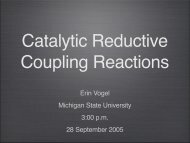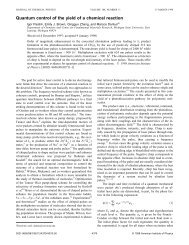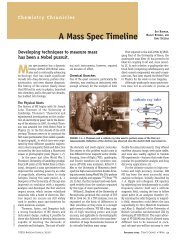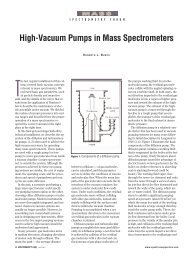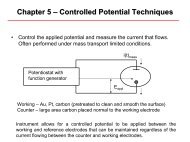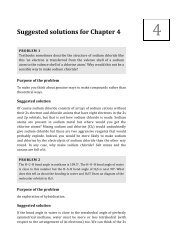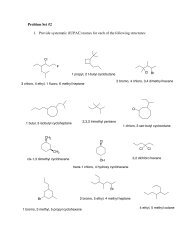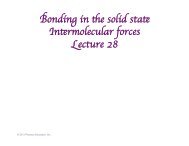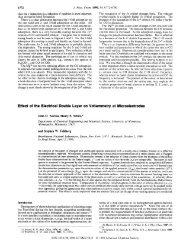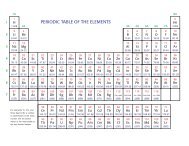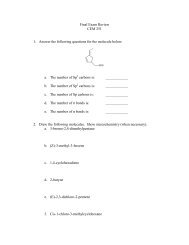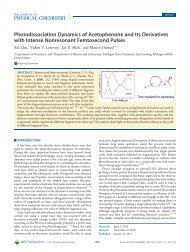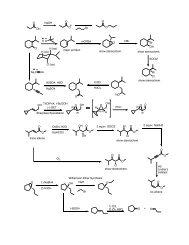Experimental Design in organic synthesis - Michigan State University
Experimental Design in organic synthesis - Michigan State University
Experimental Design in organic synthesis - Michigan State University
You also want an ePaper? Increase the reach of your titles
YUMPU automatically turns print PDFs into web optimized ePapers that Google loves.
Statistical <strong>Design</strong> of<br />
Experiments Applied to<br />
Organic Synthesis<br />
Luis Sanchez<br />
<strong>Michigan</strong> <strong>State</strong> <strong>University</strong><br />
October 11 th , 2006
• Statistical <strong>Design</strong> of Experiments<br />
• Methodology developed <strong>in</strong> 1958 by the<br />
British statistician Ronald Fisher<br />
DoE<br />
• Strategy<br />
• Appropriate statistical analysis before any<br />
experimental data are obta<strong>in</strong>ed<br />
• Objective<br />
• To get as much <strong>in</strong>formation as possible<br />
from a m<strong>in</strong>imum number of experiments<br />
Bayne, C. K.; Rub<strong>in</strong>, I. B., Practical experimental designs and optimization methods for chemists. VCH<br />
Publishers, USA, 1986.<br />
Tranter, R., <strong>Design</strong> and analysis <strong>in</strong> chemical research. Sheffield Academic; CRC Press: Sheffield, England, 2000.
• Experimentation <strong>in</strong> Organic <strong>synthesis</strong><br />
• In any synthetical procedure there are factors<br />
temperature, time, pressure, reagents, rate of<br />
addition, catalyst, solvent, concentration, pH<br />
that will have an <strong>in</strong>fluence on the result<br />
yield, purity, selectivity<br />
Carlson, R., <strong>Design</strong> and optimization <strong>in</strong> <strong>organic</strong> <strong>synthesis</strong>. Elsevier: Amsterdam ; New York, 1992.
• Conventional approach to optimization<br />
X+Y<br />
T°C<br />
t m<strong>in</strong>utes<br />
• Analysis of the reaction conditions that affect the yield:<br />
Z<br />
Yield vs. Temperature (t=130 m<strong>in</strong>)<br />
Yield vs. Reaction time (T=125°C)<br />
80<br />
80<br />
Yield (%)<br />
75<br />
70<br />
65<br />
Yield (%)<br />
75<br />
70<br />
65<br />
60<br />
60<br />
55<br />
105 115 125 135 145 155<br />
55<br />
40 70 100 130 160 190<br />
Temperature (°C)<br />
Time (m<strong>in</strong>)<br />
• The maximum yield would be obta<strong>in</strong>ed at 125 °C <strong>in</strong> 130 m<strong>in</strong>?<br />
?<br />
Are these really the optimum conditions?<br />
Tranter, R., <strong>Design</strong> and analysis <strong>in</strong> chemical research. Sheffield Academic; CRC Press: Sheffield, England, 2000.
• How yield actually behaves<br />
actual<br />
maximum<br />
155<br />
Yield vs (Time and Temperature)<br />
Temperature (°C)<br />
145<br />
135<br />
125<br />
115<br />
94<br />
60<br />
90<br />
70<br />
80<br />
maximum local<br />
maximum yield<br />
“response surface”<br />
105<br />
55 80 105 130 155 180<br />
Time (m<strong>in</strong>)<br />
Carlson, R., <strong>Design</strong> and optimization <strong>in</strong> <strong>organic</strong> <strong>synthesis</strong>. Elsevier: Amsterdam ; New York, 1992.<br />
Tranter, R., <strong>Design</strong> and analysis <strong>in</strong> chemical research. Sheffield Academic; CRC Press: Sheffield, England, 2000.
• The conventional approach<br />
• Analysis of the effect of one particular reaction condition<br />
by keep<strong>in</strong>g all the other ones constant<br />
A+B<br />
catalyst<br />
T°C<br />
tm<strong>in</strong>utes<br />
C<br />
Amount of<br />
Catalyst<br />
Temperature<br />
Concentration<br />
of substrate<br />
The problem:<br />
• The optimum conditions obta<strong>in</strong>ed depend on the start<strong>in</strong>g po<strong>in</strong>t<br />
Owen, M. R.; Luscombe, C.; Lai, L. W.; Godbert, S.; Crookes, D. L.; Emiabata-Smith, D.<br />
Org. Proc. Res. Dev. 2001, 5, 308-323.
• The DoE approach<br />
• To rationally choose po<strong>in</strong>ts throughout the cube to fully<br />
represent the entire space.<br />
A+B<br />
catalyst<br />
T°C<br />
tm<strong>in</strong>utes<br />
C<br />
Amount of<br />
Catalyst<br />
Temperature<br />
Concentration<br />
of substrate<br />
Owen, M. R.; Luscombe, C.; Lai, L. W.; Godbert, S.; Crookes, D. L.; Emiabata-Smith, D.<br />
Org. Proc. Res. Dev. 2001, 5, 308-323.
• Outl<strong>in</strong>e<br />
• Determ<strong>in</strong><strong>in</strong>g important reaction conditions<br />
• Fractional factorial design<br />
• Analysis of reaction condition effects<br />
• Factorial design<br />
• Estimation of the optimum conditions<br />
• Response surface analysis
• Factorial designs<br />
• Two types of reaction conditions:<br />
• Numeric<br />
temperature, pH, rate of addition, concentration<br />
• Categoric<br />
solvent, <strong>in</strong>ert atmosphere, presence of molecular<br />
sieves, use of a particular reagent<br />
• Each reaction condition will be screened over a def<strong>in</strong>ed<br />
set of values (numeric) or options (categoric)<br />
• Experiments are run us<strong>in</strong>g all the possible comb<strong>in</strong>ations
•mm n Factorial designs<br />
number of values<br />
for each reaction<br />
condition<br />
m n<br />
number of<br />
reaction<br />
conditions<br />
• If we analyze 2 values (or options) for 3 reaction<br />
conditions, 2 3 =8 experiments need to be run<br />
• A m n factorial design requires m n experiments<br />
• The most used method is 2 n design
•22 3 factorial design<br />
ROOC<br />
OH<br />
COOR<br />
T°C<br />
ROOC<br />
COOR<br />
COOR<br />
H 2 O<br />
acid catalyst<br />
(H 2 SO 4 /H 3 PO 4 )<br />
COOR<br />
• 2 values (or options) for 3 reaction conditions:<br />
T<br />
Temperature<br />
(°C)<br />
C<br />
Concentration<br />
(M)<br />
K<br />
Catalyst<br />
120 160 1.5 2.5 H 3 PO 4 H 2 SO 4<br />
-1 +1 -1 +1 -1 +1<br />
number of<br />
values<br />
(-1,1,-1)<br />
(-1,1,1)<br />
(-1,-1,1)<br />
(-1,-1,-1)<br />
C<br />
number of<br />
conditions<br />
2 3 K<br />
(1,1,1)<br />
(1,1,-1)<br />
(1,-1,1)<br />
(1,-1,-1)<br />
T<br />
Box, G. E. P.; Hunter, W. G.; Hunter, J. S., Statistics for experimenters : an <strong>in</strong>troduction to design, data analysis,<br />
and model build<strong>in</strong>g. Wiley: New York, 1978.
•22 3 factorial design<br />
ROOC<br />
OH<br />
COOR<br />
T°C<br />
ROOC<br />
COOR<br />
COOR<br />
H 2 O<br />
acid catalyst<br />
(H 2 SO 4 /H 3 PO 4 )<br />
COOR<br />
• 8 experimental runs:<br />
run T C K label<br />
1 - - - 1<br />
2 + - - t<br />
3 - + - c<br />
4 + + - tc<br />
5 - - + k<br />
6 + - + tk<br />
7 - + + ck<br />
8 + + + tck<br />
yield (%)<br />
60<br />
72<br />
54<br />
68<br />
52<br />
83<br />
45<br />
80<br />
Box, G. E. P.; Hunter, W. G.; Hunter, J. S., Statistics for experimenters : an <strong>in</strong>troduction to design, data analysis,<br />
and model build<strong>in</strong>g. Wiley: New York, 1978.
un<br />
T<br />
C<br />
K<br />
label<br />
yield (%)<br />
1<br />
-<br />
-<br />
-<br />
1<br />
60<br />
2<br />
+<br />
-<br />
-<br />
t<br />
72<br />
3<br />
-<br />
+<br />
-<br />
c<br />
54<br />
4<br />
+<br />
+<br />
-<br />
tc<br />
68<br />
5<br />
-<br />
-<br />
+<br />
k<br />
52<br />
6<br />
+<br />
-<br />
+<br />
tk<br />
83<br />
7<br />
-<br />
+<br />
+<br />
ck<br />
45<br />
8<br />
+<br />
+<br />
+<br />
tck<br />
80<br />
Box, G. E. P.; Hunter, W. G.; Hunter, J. S., Statistics for experimenters : an <strong>in</strong>troduction to design, data analysis,<br />
and model build<strong>in</strong>g. Wiley: New York, 1978.
• Measur<strong>in</strong>g the effect: Temperature<br />
run T C K label<br />
1 - - - 1<br />
2 + - - t<br />
3 - + - c<br />
4 + + - tc<br />
5 - - + k<br />
6 + - + tk<br />
7 - + + ck<br />
8 + + + tck<br />
yield (%)<br />
60<br />
72<br />
54<br />
68<br />
52<br />
83<br />
45<br />
80<br />
12<br />
14<br />
31<br />
35<br />
(-1,1,-1)<br />
(-1,1,1)<br />
(-1,-1,1)<br />
(-1,-1,-1)<br />
Effect of T<br />
(1,1,1)<br />
(1,1,-1)<br />
(1,-1,1)<br />
(1,-1,-1)<br />
One half of the average of<br />
the differences of each pair<br />
=<br />
⎡(t<br />
⎢<br />
⎣<br />
−1)<br />
+ (tc<br />
− c) + (tk<br />
4<br />
2<br />
− k) + (tck<br />
− ck) ⎤<br />
⎥<br />
⎦<br />
=<br />
⎡ 12 + 14 + 31+<br />
35⎤<br />
⎢ 4 ⎥<br />
⎣<br />
⎦<br />
2<br />
= 11.5<br />
Box, G. E. P.; Hunter, W. G.; Hunter, J. S., Statistics for experimenters : an <strong>in</strong>troduction to design, data analysis,<br />
and model build<strong>in</strong>g. Wiley: New York, 1978.
• Measur<strong>in</strong>g the effect: Concentration<br />
run T C K label<br />
1 - - - 1<br />
2 + - - t<br />
yield (%)<br />
60<br />
72<br />
-6<br />
Effect of C<br />
3 - + - c<br />
4 + + - tc<br />
54<br />
68<br />
-4<br />
5 - - + k<br />
6 + - + tk<br />
7 - + + ck<br />
8 + + + tck<br />
52<br />
83<br />
45<br />
80<br />
-7<br />
-3<br />
One half of the average of<br />
the differences of each pair<br />
=<br />
⎡(c<br />
⎢<br />
⎣<br />
−1)<br />
+ (tc<br />
− t) + (ck<br />
4<br />
2<br />
− k) + (tck<br />
− tk) ⎤<br />
⎥<br />
⎦<br />
=<br />
⎡(<br />
−6)<br />
+ ( −4)<br />
+ ( −7)<br />
+ ( −3)<br />
⎤<br />
⎢ 4 ⎥<br />
⎣<br />
⎦<br />
2<br />
= −2.5<br />
Box, G. E. P.; Hunter, W. G.; Hunter, J. S., Statistics for experimenters : an <strong>in</strong>troduction to design, data analysis,<br />
and model build<strong>in</strong>g. Wiley: New York, 1978.
• Measur<strong>in</strong>g the effect: Catalyst<br />
run T C K label<br />
1 - - - 1<br />
2 + - - t<br />
3 - + - c<br />
4 + + - tc<br />
yield (%)<br />
60<br />
72<br />
54<br />
68<br />
-8<br />
11<br />
-9<br />
Effect of K<br />
5 - - + k<br />
6 + - + tk<br />
7 - + + ck<br />
8 + + + tck<br />
52<br />
83<br />
45<br />
80<br />
12<br />
One half of the average of<br />
the differences of each pair<br />
=<br />
⎡(k<br />
⎢<br />
⎣<br />
−1)<br />
+ (tk<br />
− t) + (ck<br />
4<br />
2<br />
− c) + (tck<br />
− tc) ⎤<br />
⎥<br />
⎦<br />
=<br />
⎡ ( −8)<br />
+ 11+<br />
( −9)<br />
+ 12⎤<br />
⎢ 4 ⎥<br />
⎣<br />
⎦<br />
2<br />
=<br />
0.75<br />
Box, G. E. P.; Hunter, W. G.; Hunter, J. S., Statistics for experimenters : an <strong>in</strong>troduction to design, data analysis,<br />
and model build<strong>in</strong>g. Wiley: New York, 1978.
• Concentration-temperature <strong>in</strong>teraction<br />
run T C K label<br />
1 - - - 1<br />
2 + - - t<br />
3 - + - c<br />
4 + + - tc<br />
yield (%)<br />
60<br />
12<br />
72<br />
54<br />
14<br />
68<br />
6<br />
7<br />
1<br />
Effect of C on the<br />
effect of T<br />
5 - - + k<br />
6 + - + tk<br />
7 - + + ck<br />
8 + + + tck<br />
52<br />
83<br />
45<br />
80<br />
31<br />
35<br />
15.5<br />
17.5<br />
2<br />
One half of the average<br />
of the differences of<br />
each pair of effects<br />
⎧⎡(tc<br />
− c) (t −1)<br />
⎤ ⎡(tck<br />
− ck) (tk − k) ⎤⎫<br />
⎧⎡14<br />
12⎤<br />
⎡35<br />
31⎤⎫<br />
⎨⎢<br />
− +<br />
2 ⎨<br />
⎬ 2<br />
2 2 ⎢<br />
−<br />
+<br />
2 2 ⎥⎬<br />
⎢<br />
−<br />
2 2 ⎥ ⎢<br />
−<br />
2 2 ⎥<br />
on<br />
⎩⎣<br />
⎥<br />
⎦ ⎣<br />
⎦⎭<br />
⎩⎣<br />
⎦ ⎣ ⎦<br />
=<br />
=<br />
⎭<br />
= 0.75<br />
2<br />
2<br />
Box, G. E. P.; Hunter, W. G.; Hunter, J. S., Statistics for experimenters : an <strong>in</strong>troduction to design, data analysis,<br />
and model build<strong>in</strong>g. Wiley: New York, 1978.
• Temperature-concentration <strong>in</strong>teraction<br />
run T C K label<br />
1 - - - 1<br />
2 + - - t<br />
3 - + - c<br />
4 + + - tc<br />
yield (%)<br />
60<br />
72<br />
54<br />
68<br />
-6<br />
-4<br />
-3<br />
-2<br />
1<br />
Effect of T on the<br />
effect of C<br />
5 - - + k<br />
6 + - + tk<br />
7 - + + ck<br />
8 + + + tck<br />
52<br />
83<br />
45<br />
80<br />
-7<br />
-3<br />
-3.5<br />
-1.5<br />
2<br />
One half of the average<br />
of the differences of<br />
each pair of effects<br />
⎧⎡(tc<br />
− t) (c −1)<br />
⎤ ⎡(tck<br />
− tk) (ck − k) ⎤⎫<br />
⎧⎡(<br />
−4)<br />
( −6)<br />
⎤ ⎡(<br />
−3)<br />
( −7)<br />
⎤⎫<br />
⎨⎢<br />
−<br />
2 ⎨<br />
⎬ 2<br />
2 2 ⎥<br />
+ ⎢ −<br />
+<br />
2 2 ⎥⎬<br />
⎢ −<br />
2 2 ⎥ ⎢ −<br />
2 2 ⎥<br />
on<br />
⎩⎣<br />
⎦ ⎣<br />
⎦⎭<br />
⎩⎣<br />
⎦ ⎣ ⎦<br />
=<br />
=<br />
⎭<br />
= 0.75<br />
2<br />
2<br />
Box, G. E. P.; Hunter, W. G.; Hunter, J. S., Statistics for experimenters : an <strong>in</strong>troduction to design, data analysis,<br />
and model build<strong>in</strong>g. Wiley: New York, 1978.
• Concentration-temperature <strong>in</strong>teraction<br />
run T C K label<br />
1 - - - 1<br />
2 + - - t<br />
3 - + - c<br />
4 + + - tc<br />
yield (%)<br />
60<br />
12<br />
72<br />
54<br />
14<br />
68<br />
6<br />
7<br />
1<br />
Effect of C on the<br />
effect of T<br />
5 - - + k<br />
6 + - + tk<br />
7 - + + ck<br />
8 + + + tck<br />
52<br />
83<br />
45<br />
80<br />
31<br />
35<br />
15.5<br />
17.5<br />
2<br />
One half of the average<br />
of the differences of<br />
each pair of effects<br />
⎧⎡(tc<br />
− c) (t −1)<br />
⎤ ⎡(tck<br />
− ck) (tk − k) ⎤⎫<br />
⎧⎡14<br />
12⎤<br />
⎡35<br />
31⎤⎫<br />
⎨⎢<br />
−<br />
2 ⎨<br />
⎬ 2<br />
2 2 ⎥<br />
+ ⎢ −<br />
+<br />
2 2 ⎥⎬<br />
⎢<br />
−<br />
2 2 ⎥ ⎢<br />
−<br />
2 2 ⎥<br />
on<br />
⎩⎣<br />
⎦ ⎣<br />
⎦⎭<br />
⎩⎣<br />
⎦ ⎣ ⎦<br />
=<br />
=<br />
⎭<br />
= 0.75<br />
2<br />
2<br />
Box, G. E. P.; Hunter, W. G.; Hunter, J. S., Statistics for experimenters : an <strong>in</strong>troduction to design, data analysis,<br />
and model build<strong>in</strong>g. Wiley: New York, 1978.
• Temperature-catalyst <strong>in</strong>teraction<br />
run T C K label<br />
yield (%)<br />
1 - - - 1<br />
2 + - - t<br />
3 - + - c<br />
4 + + - tc<br />
60<br />
72<br />
54<br />
68<br />
12<br />
14<br />
6<br />
7<br />
9.5<br />
5 - - + k<br />
6 + - + tk<br />
7 - + + ck<br />
8 + + + tck<br />
52<br />
83<br />
45<br />
80<br />
31<br />
35<br />
15.5<br />
17.5<br />
10.5<br />
One half of the average<br />
of the differences of<br />
each pair of effects<br />
⎧⎡(tk<br />
− k) (t −1)<br />
⎤ ⎡(tck<br />
− ck) (tc − c) ⎤⎫<br />
⎧⎡31<br />
12⎤<br />
⎡35<br />
14⎤⎫<br />
⎨⎢<br />
−<br />
2 ⎨<br />
⎬ 2<br />
2 2 ⎥<br />
+ ⎢ −<br />
+<br />
2 2 ⎥⎬<br />
⎢<br />
−<br />
2 2 ⎥ ⎢<br />
−<br />
2 2 ⎥<br />
on<br />
⎩⎣<br />
⎦ ⎣<br />
⎦⎭<br />
⎩⎣<br />
⎦ ⎣ ⎦<br />
=<br />
=<br />
⎭<br />
= 5<br />
2<br />
2<br />
Box, G. E. P.; Hunter, W. G.; Hunter, J. S., Statistics for experimenters : an <strong>in</strong>troduction to design, data analysis,<br />
and model build<strong>in</strong>g. Wiley: New York, 1978.
• TCK <strong>in</strong>teraction<br />
run T C K label<br />
yield (%)<br />
1 - - - 1<br />
2 + - - t<br />
3 - + - c<br />
4 + + - tc<br />
60<br />
72<br />
54<br />
68<br />
12<br />
14<br />
6<br />
7<br />
9.5<br />
4.75<br />
0.5<br />
5 - - + k<br />
6 + - + tk<br />
52<br />
83<br />
31<br />
15.5<br />
10.5<br />
5.25<br />
7 - + + ck<br />
8 + + + tck<br />
45<br />
80<br />
35<br />
17.5<br />
⎧⎡(tck<br />
− ck) (tc − c) ⎤ ⎡(tk<br />
− k) (t −1)<br />
⎤⎫<br />
⎧⎡35<br />
14⎤<br />
⎡31<br />
12⎤⎫<br />
⎨⎢<br />
−<br />
2 ⎨<br />
⎬ 2<br />
2 2 ⎥<br />
− ⎢ −<br />
−<br />
2 2 ⎥⎬<br />
⎢<br />
−<br />
2 2 ⎥ ⎢<br />
−<br />
2 2 ⎥<br />
on<br />
⎩⎣<br />
⎦ ⎣<br />
⎦⎭<br />
⎩⎣<br />
⎦ ⎣ ⎦<br />
=<br />
=<br />
⎭<br />
= 0.25<br />
2<br />
2<br />
Box, G. E. P.; Hunter, W. G.; Hunter, J. S., Statistics for experimenters : an <strong>in</strong>troduction to design, data analysis,<br />
and model build<strong>in</strong>g. Wiley: New York, 1978.
• Measur<strong>in</strong>g the effect and <strong>in</strong>teractions<br />
• Yates’s algorithm: works for any 2 n factorial design<br />
run T C K label<br />
yield (%)<br />
(1)<br />
(2)<br />
(3)<br />
div<br />
result<br />
1 - - - 1<br />
60<br />
132<br />
254<br />
514<br />
8<br />
64.25<br />
average<br />
2 + - - t<br />
72<br />
122<br />
260<br />
92<br />
8<br />
11.5<br />
T<br />
3 - + - c<br />
54<br />
135<br />
26<br />
-20<br />
8<br />
-2.5<br />
C<br />
4 + + - tc<br />
68<br />
125<br />
66<br />
6<br />
8<br />
0.75<br />
TC<br />
5 - - + k<br />
52<br />
12<br />
-10<br />
6<br />
8<br />
0.75<br />
K<br />
6 + - + tk<br />
83<br />
14<br />
-10<br />
40<br />
8<br />
5.0<br />
TK<br />
7 - + + ck<br />
45<br />
31<br />
2<br />
0<br />
8<br />
0<br />
CK<br />
8 + + + tck<br />
80<br />
35<br />
4<br />
2<br />
8<br />
0.25<br />
TCK<br />
Box, G. E. P.; Hunter, W. G.; Hunter, J. S., Statistics for experimenters : an <strong>in</strong>troduction to design, data analysis,<br />
and model build<strong>in</strong>g. Wiley: New York, 1978.
• What do those numbers mean?<br />
• First we need to evaluate if they are significant<br />
3x<br />
3x<br />
(when there is<br />
no central po<strong>in</strong>t)<br />
Effect<br />
14<br />
12<br />
10<br />
8<br />
6<br />
4<br />
2<br />
0<br />
-2<br />
-4<br />
Factor effect plot<br />
T C TC K TK CK TCK<br />
Factor<br />
• If the effect of a factor is lower than the standard<br />
deviation, it’s likely to be due to experimental error
• What do those numbers mean?<br />
• The effects can be used to calculate a function that<br />
represents all the experimental runs<br />
average<br />
T<br />
C<br />
TC<br />
K<br />
TK<br />
CK<br />
TCK<br />
result<br />
64.25<br />
11.5<br />
-2.5<br />
0.75<br />
0.75<br />
5.0<br />
0<br />
0.25<br />
yield = 64.25 + 11.5T − 2.5C + 5TK<br />
±<br />
run T C K label yield (%) calculated<br />
1 - - - 1 60 60.25 ± 2<br />
2 + - - t 72 73.25 ± 2<br />
3 - + - c 54 55.25 ± 2<br />
4 + + - tc 68 68.25 ± 2<br />
5 - - + k 52 50.25 ± 2<br />
6 + - + tk 83 83.25 ± 2<br />
7 - + + ck 45 45.25 ± 2<br />
8 + + + tck 80 78.25 ± 2
• The mean<strong>in</strong>g of those numbers<br />
yield<br />
= 64.25 + 11.5T − 2.5C + 5TK<br />
±<br />
T<br />
Temperature<br />
(°C)<br />
C<br />
Concentration<br />
(M)<br />
K<br />
Catalyst<br />
120 160 1.5 2.5 H 3 PO 4 H 2 SO 4<br />
-1 +1 -1 +1 -1 +1<br />
• Categorical reaction conditions can be optimized<br />
ROOC<br />
OH<br />
COOR<br />
H 2 SO 4(aq)<br />
ROOC<br />
COOR<br />
COOR<br />
heat<br />
COOR<br />
yield<br />
= 64.25 + 16.5T − 2.5C<br />
±
• Someth<strong>in</strong>g important<br />
• It was possible to choose one catalyst because the<br />
<strong>in</strong>teraction TK was identified<br />
yield<br />
= 64.25 + 11.5T − 2.5C + 5TK<br />
±<br />
run T C K<br />
yield (%)<br />
1 - - -<br />
2 + - -<br />
3 - + -<br />
4 + + -<br />
5 - - +<br />
6 + - +<br />
7 - + +<br />
60<br />
72<br />
54<br />
68<br />
52<br />
83<br />
45<br />
H 3<br />
PO 4<br />
H 2<br />
SO 4<br />
In order to get the<br />
maximum yield<br />
(maximize the function),<br />
the catalyst has to be<br />
H 2 SO 4<br />
8 + + +<br />
80
• The mean<strong>in</strong>g of those numbers<br />
ROOC<br />
OH<br />
COOR<br />
H 2 SO 4(aq)<br />
ROOC<br />
COOR<br />
COOR<br />
heat<br />
COOR<br />
yield<br />
= 64.25 + 16.5T − 2.5C<br />
±<br />
45.25<br />
yield<br />
83.25<br />
• To f<strong>in</strong>d the optimum<br />
conditions, we need to make<br />
sure that this function<br />
represents the entire space<br />
C<br />
T
• Other factorial designs<br />
• Full factorial design<br />
• Central composite<br />
• Box-Benhken<br />
Tye, H. Drug Discovery Today 2004, 9, 485-491.
• Outl<strong>in</strong>e<br />
• Determ<strong>in</strong><strong>in</strong>g important reaction conditions<br />
• Fractional factorial design<br />
• Analysis of reaction condition effects<br />
• Factorial design<br />
• Estimation of the optimum conditions<br />
• Response surface analysis
• Fractional Factorial designs<br />
• Factorial designs work perfectly for determ<strong>in</strong><strong>in</strong>g<br />
important factors<br />
…if you have 3 reaction conditions, as <strong>in</strong> the example<br />
ROOC<br />
OH<br />
COOR<br />
T°C<br />
ROOC<br />
COOR<br />
COOR<br />
H 2 O<br />
acid catalyst<br />
(H 2 SO 4 /H 3 PO 4 )<br />
COOR<br />
• If you had to analyze 7 reaction conditions at 2 values<br />
each, you would need to run 2 7 =128 experiments!<br />
• By virtue of statistics, it is possible to lower that number<br />
and get the same <strong>in</strong>formation
•mm n-p Fractional Factorial designs<br />
number of values<br />
for each reaction<br />
condition<br />
m n-p<br />
actual number<br />
of reaction<br />
conditions<br />
number of “ignored”<br />
reaction conditions<br />
• A m n-p fractional factorial design requires m n-p experiments<br />
• If we analyze 2 values or options for 4 reaction conditions<br />
(as if they were only 3), 2 4-1 =8 experiments need to be run<br />
Tranter, R., <strong>Design</strong> and analysis <strong>in</strong> chemical research. Sheffield Academic; CRC Press: Sheffield, England, 2000.
• Effects vs. <strong>in</strong>teractions<br />
• This is what we<br />
got before:<br />
Important?<br />
result<br />
ma<strong>in</strong> effects<br />
Very often<br />
average<br />
T<br />
64.25<br />
11.5<br />
2-factor <strong>in</strong>teractions<br />
Often<br />
C<br />
TC<br />
K<br />
-2.5<br />
0.75<br />
0.75<br />
3-factor <strong>in</strong>teractions<br />
4-factor <strong>in</strong>teractions<br />
Sometimes<br />
Very rarely<br />
TK<br />
CK<br />
TCK<br />
5.0<br />
0<br />
0.25<br />
more-than-5-factor<br />
<strong>in</strong>teractions<br />
If you get to here you<br />
have someth<strong>in</strong>g very<br />
unusual!<br />
Tranter, R., <strong>Design</strong> and analysis <strong>in</strong> chemical research. Sheffield Academic; CRC Press: Sheffield, England, 2000
•22 4-1 Fractional factorial design<br />
• Yates’s algorithm:<br />
run A B C D<br />
yield (%)<br />
(1)<br />
(2)<br />
(3)<br />
div<br />
result<br />
1 - - - -<br />
#<br />
#<br />
#<br />
#<br />
8<br />
#<br />
av + ABCD<br />
2 + - - +<br />
#<br />
#<br />
#<br />
#<br />
8<br />
#<br />
A + BCD<br />
3 - + - +<br />
#<br />
#<br />
#<br />
#<br />
8<br />
#<br />
B + ACD<br />
4 + + - -<br />
#<br />
#<br />
#<br />
#<br />
8<br />
#<br />
AB + CD<br />
5 - - + +<br />
#<br />
#<br />
#<br />
#<br />
8<br />
#<br />
C + ABD<br />
6 + - + -<br />
#<br />
#<br />
#<br />
#<br />
8<br />
#<br />
AC + BD<br />
7 - + + -<br />
#<br />
#<br />
#<br />
#<br />
8<br />
#<br />
BC + AD<br />
8 + + + +<br />
#<br />
#<br />
#<br />
#<br />
8<br />
#<br />
ABC + D<br />
Box, G. E. P.; Hunter, W. G.; Hunter, J. S., Statistics for experimenters : an <strong>in</strong>troduction to design, data analysis,<br />
and model build<strong>in</strong>g. Wiley: New York, 1978.
• Fractional factorial designs<br />
Number of experimental runs<br />
Number of reaction conditions<br />
<strong>Design</strong> Expert 7.0.3 (Stat-Ease Inc.) (http://www.statease.com)
• How to compare the effects?<br />
• In the case of 3 reaction conditions, a “Factor effect plot”<br />
is enough<br />
Effect<br />
14<br />
12<br />
10<br />
8<br />
6<br />
4<br />
2<br />
0<br />
-2<br />
-4<br />
Factor effect plot<br />
T C TC K TK CK TCK<br />
Factor<br />
• For a high number of reactions, a normal plot is needed
• Normal plots<br />
• Let’s assume that the experimental error follows a<br />
normal distribution<br />
% error<br />
• In a normal plot, reaction condition<br />
effects that are due to experimental error<br />
will appear form<strong>in</strong>g a straight l<strong>in</strong>e<br />
Normal plot<br />
Box, G. E. P.; Hunter, W. G.; Hunter, J. S., Statistics for experimenters : an <strong>in</strong>troduction to design, data analysis,<br />
and model build<strong>in</strong>g. Wiley: New York, 1978.
• Application example<br />
O<br />
O<br />
O<br />
Br<br />
HO<br />
NO 2<br />
H<br />
N<br />
1<br />
N<br />
PivO OPiv<br />
O<br />
OPiv<br />
O O<br />
2<br />
O<br />
N CF 3<br />
Ag 2 O PivO OPiv<br />
mol.sieves<br />
OPiv<br />
18h<br />
NO 2<br />
H<br />
N<br />
3<br />
N<br />
N CF 3<br />
(Koenigs-Knorr<br />
glucuronidation)<br />
3%<br />
• Chelation was identified as the reason for the bad yield<br />
• Addition of TMEDA (10 equiv.), <strong>in</strong>creased the yield to 27%<br />
TMEDA =<br />
N<br />
N<br />
Stazi, F.; Palmisano, G.; Turconi, M.; Cl<strong>in</strong>i, S.; Santagost<strong>in</strong>o, M. J. Org. Chem. 2004, 69, 1097-1103.
• Application example<br />
O<br />
O Br<br />
O<br />
HO<br />
NO 2<br />
H<br />
N<br />
1<br />
N<br />
PivO OPiv<br />
O<br />
OPiv<br />
O O<br />
2<br />
O<br />
N CF 3<br />
Ag 2 O PivO OPiv<br />
10 equiv. TMEDA<br />
OPiv<br />
NO 2<br />
H<br />
N<br />
3<br />
N<br />
N CF 3<br />
mol.sieves<br />
18h<br />
27 %<br />
• DoE methods (3 2 factorial design) were applied to screen am<strong>in</strong>e<br />
additives and silver sources giv<strong>in</strong>g: HMTTA and Ag 2 CO 3 as best<br />
comb<strong>in</strong>ation<br />
N<br />
HMTTA =<br />
N<br />
N<br />
N
• Application example<br />
HO<br />
NO 2<br />
H<br />
N<br />
1<br />
N<br />
O<br />
O<br />
O<br />
Br<br />
PivO OPiv<br />
O<br />
NO<br />
OPiv<br />
2<br />
H<br />
O O N<br />
2<br />
O<br />
N CF 3<br />
Ag 2 CO 3 PivO OPiv<br />
10 equiv. HMTTA<br />
OPiv<br />
3<br />
mol.sieves<br />
18h<br />
42 %<br />
• A 2 7-4 fractional factorial (8 experiments) design was used:<br />
N<br />
N CF 3<br />
Reaction condition -1 +1<br />
A pre-complex time (m<strong>in</strong>) 0 60<br />
B reaction time (h) 2 6<br />
C Ag 2<br />
CO 3<br />
(equiv) 1.5 3.8<br />
D HMTTA (equiv) 1.5 12.6<br />
E sugar derivative (equiv) 1.5 3<br />
F 4 Å mol sieves (mg) 0 100<br />
G solvent (mL) 0.5 1.5
• Application example<br />
• 2 7-4 factorial design results:<br />
run A B C D E F G yield (%)<br />
1 - - - + + + - 14.7<br />
2 + - - - - + + 19.5<br />
3 - + - - + - + 24.4<br />
4 + + - + - - - 11.2<br />
5 - - + + - - + 34.2<br />
6 + - + - + - - 83.2<br />
7 - + + - - + - 56.5<br />
8 + + + + + + + 55.4<br />
A<br />
B<br />
C<br />
D<br />
E<br />
F<br />
G<br />
pre-complex time (m<strong>in</strong>)<br />
reaction time (h)<br />
Ag 2<br />
CO 3<br />
(equiv)<br />
HMTTA (equiv)<br />
sugar derivative (equiv)<br />
4 Å mol sieves (mg)<br />
solvent (mL)<br />
Stazi, F.; Palmisano, G.; Turconi, M.; Cl<strong>in</strong>i, S.; Santagost<strong>in</strong>o, M. J. Org. Chem. 2004, 69, 1097-1103.
• Application example<br />
O<br />
O<br />
O<br />
Br<br />
HO<br />
NO 2<br />
H<br />
N<br />
N<br />
PivO OPiv O<br />
(2.4 eq.) OPiv<br />
O O<br />
O<br />
N CF 3 Ag 2 CO 3 (3.7 eq) PivO OPiv<br />
HMTTA (0.7 eq)<br />
OPiv<br />
30 m<strong>in</strong><br />
NO 2<br />
H<br />
N<br />
86%<br />
N<br />
N CF 3<br />
• F<strong>in</strong>ally, a 2 3 factorial design and<br />
response surface analysis gave<br />
the optimum conditions<br />
Stazi, F.; Palmisano, G.; Turconi, M.; Cl<strong>in</strong>i, S.; Santagost<strong>in</strong>o, M. J. Org. Chem. 2004, 69, 1097-1103.
• Outl<strong>in</strong>e<br />
• Determ<strong>in</strong><strong>in</strong>g important reaction conditions<br />
• Fractional factorial design<br />
• Analysis of reaction condition effects<br />
• Factorial design<br />
• Estimation of the optimum conditions<br />
• Response surface analysis
• Response surface analysis<br />
• The problem of optimiz<strong>in</strong>g a synthetic reaction corresponds to<br />
locate the maximum value of a function from a mathematical<br />
po<strong>in</strong>t of view<br />
yield<br />
yield<br />
Carlson, R., <strong>Design</strong> and optimization <strong>in</strong> <strong>organic</strong> <strong>synthesis</strong>. Elsevier: Amsterdam; New York, 1992.
• Response surface analysis<br />
ROOC<br />
OH<br />
COOR<br />
COOR<br />
H 2 SO 4(aq) 1.0M<br />
T°C<br />
tm<strong>in</strong><br />
ROOC<br />
COOR<br />
COOR<br />
t<br />
time<br />
(m<strong>in</strong>)<br />
T<br />
Temperature<br />
(°C)<br />
70 80 127.5 132.5<br />
-1 +1 -1 +1<br />
run t T<br />
1 - -<br />
2 + -<br />
3 - +<br />
4 + +<br />
5 0 0<br />
6 0 0<br />
7 0 0<br />
Central po<strong>in</strong>t:<br />
three times to<br />
calculate the<br />
experimental error<br />
Box, G. E. P.; Hunter, W. G.; Hunter, J. S., Statistics for experimenters : an <strong>in</strong>troduction to design, data analysis,<br />
and model build<strong>in</strong>g. Wiley: New York, 1978.
• Response surface analysis<br />
ROOC<br />
OH<br />
COOR<br />
COOR<br />
H 2 SO 4(aq) 1.0M<br />
T°C<br />
tm<strong>in</strong><br />
ROOC<br />
COOR<br />
COOR<br />
yield<br />
= 62.01+<br />
2.35t + 4.5T<br />
±<br />
run t T yield (%)<br />
1 - - 54.3<br />
2 + - 60.3<br />
3 - + 64.6<br />
4 + + 68.0<br />
5 0 0 60.3<br />
6 0 0 64.3<br />
8 0 0 62.3<br />
3 central po<strong>in</strong>ts<br />
e = 2<br />
Temperature (°C)<br />
Yield vs. (Time and Temperature)<br />
135<br />
133<br />
131<br />
129<br />
127<br />
64.6<br />
54.3<br />
62.3<br />
68.0<br />
60.3<br />
125<br />
65 70 75 80 85<br />
time (m<strong>in</strong>)<br />
Box, G. E. P.; Hunter, W. G.; Hunter, J. S., Statistics for experimenters : an <strong>in</strong>troduction to design, data analysis,<br />
and model build<strong>in</strong>g. Wiley: New York, 1978.
• Response surface analysis<br />
160<br />
Yield vs. (Time and Temperature)<br />
150<br />
58.2<br />
Temperature (°C)<br />
140<br />
130<br />
69.1<br />
87.4<br />
120<br />
60 70 80 90 100<br />
time (m<strong>in</strong>)<br />
110<br />
Box, G. E. P.; Hunter, W. G.; Hunter, J. S., Statistics for experimenters : an <strong>in</strong>troduction to design, data analysis,<br />
and model build<strong>in</strong>g. Wiley: New York, 1978.
• Response surface analysis<br />
155<br />
Yield vs. (Time and Temperature)<br />
• Equation for the 2 2 factorial<br />
design:<br />
91.1<br />
yield<br />
= 82 .09 − 2.69 t + 6.97T<br />
±<br />
150<br />
91.9<br />
85.9<br />
Temperature (°C)<br />
145<br />
140<br />
87.4<br />
86.8 79.3<br />
77.2 73.01<br />
• Calculated equation for the<br />
surface:<br />
yield = 87 .36 − 2.69 t +<br />
−<br />
2.15 t<br />
2<br />
−<br />
3.12T<br />
2<br />
−<br />
0.58Tt<br />
6.97T<br />
±<br />
135<br />
71.2<br />
70 80 90 100<br />
time (m<strong>in</strong>)<br />
110<br />
Box, G. E. P.; Hunter, W. G.; Hunter, J. S., Statistics for experimenters : an <strong>in</strong>troduction to design, data analysis,<br />
and model build<strong>in</strong>g. Wiley: New York, 1978.
• Response surface analysis<br />
2<br />
2<br />
yield = 87 .36 − 2.69 t + 6.97 T − 2.15 t − 3.12T − 0.58 Tt ±<br />
160<br />
Yield vs. (Time and Temperature)<br />
155<br />
93<br />
Optimum conditions:<br />
T = 157 °C<br />
t = 73 m<strong>in</strong><br />
yield: 93%<br />
Temperature (°C)<br />
150<br />
145<br />
140<br />
90<br />
88<br />
85<br />
70 80 90 100<br />
110<br />
time (m<strong>in</strong>)<br />
Box, G. E. P.; Hunter, W. G.; Hunter, J. S., Statistics for experimenters : an <strong>in</strong>troduction to design, data analysis,<br />
and model build<strong>in</strong>g. Wiley: New York, 1978.
• Sequential nature of experimentation<br />
Hypercube design<br />
<strong>in</strong> n dimensions<br />
<strong>Design</strong> <strong>in</strong> 2,3,4<br />
dimensions<br />
Plan<br />
Fractional<br />
factorial<br />
design<br />
Full factorial<br />
design<br />
Central<br />
composite<br />
Response<br />
surface analysis<br />
Tranter, R., <strong>Design</strong> and analysis <strong>in</strong> chemical research. Sheffield Academic; CRC Press: Sheffield, England, 2000.
• Application of response surface analysis<br />
TBSO<br />
R<br />
H<br />
O<br />
H<br />
O R''<br />
HO H<br />
H<br />
O R''<br />
H<br />
TEA•3HF<br />
R H<br />
+<br />
N<br />
R N<br />
O<br />
NMP<br />
O<br />
O N<br />
R'<br />
O<br />
O<br />
R'<br />
O<br />
O<br />
1 2 3<br />
• 2 4 central composite<br />
reaction condition range units<br />
temperature 10 30 °C<br />
time 19 31 hours<br />
volume of NMP 3 7 mL/g of substrate<br />
equivalents of TEA.3HF 1 1.67 Equivalents<br />
• Monitored results:<br />
• % yield of alcohol<br />
• % lactone<br />
• % rema<strong>in</strong><strong>in</strong>g silyl ether<br />
Owen, M. R.; Luscombe, C.; Lai, L. W.; Godbert, S.; Crookes, D. L.; Emiabata-Smith, D.<br />
Org. Proc. Res. Dev. 2001, 5, 308-323.<br />
O<br />
O<br />
R'
• Application of response surface analysis<br />
TBSO<br />
R<br />
H<br />
O<br />
H<br />
O R''<br />
HO H<br />
H<br />
O R''<br />
H<br />
TEA•3HF<br />
R H<br />
+<br />
N<br />
R N<br />
O<br />
NMP<br />
O<br />
O N<br />
R'<br />
O<br />
O<br />
R'<br />
O<br />
O<br />
1 2 3<br />
O<br />
O<br />
R'<br />
Owen, M. R.; Luscombe, C.; Lai, L. W.; Godbert, S.; Crookes, D. L.; Emiabata-Smith, D.<br />
Org. Proc. Res. Dev. 2001, 5, 308-323.
• Application<br />
TBSO<br />
R<br />
H<br />
O<br />
H<br />
O R''<br />
HO H<br />
H<br />
O R''<br />
H<br />
TEA•3HF<br />
R H<br />
+<br />
N<br />
R N<br />
O<br />
NMP<br />
O<br />
O N<br />
R'<br />
O<br />
O<br />
R'<br />
O<br />
O<br />
1 2 3<br />
O<br />
O<br />
R'<br />
Predicted conditions product yield (%) impurity (%)<br />
target/constra<strong>in</strong>ts T (°C) Time (h) solvent Et3N·3HF predicted actual predicted actual<br />
max yield 19 31 3.6 1.42 95.3 95.8 3.3 3.3<br />
lactone < 2% 17 31 4.8 1.50 94.2 94.0 1.9 1.7<br />
lactone < 1.1% 16 29 5.3 1.68 92.4 93.1 1.1 1.1<br />
lactone < 2%, solvent < 3.5 mL/g 14 31 3.45 1.58 93.9 94.2 1.8 2.0<br />
lactone < 2% Et 3<br />
N.3HF < 1.18eq. 28 19.5 7 1.17 93.7 93.4 1.9 2.0<br />
lactone < 2%, time < 23 h 24 23 6.3 1.41 94.2 94.2 2.0 1.9<br />
Owen, M. R.; Luscombe, C.; Lai, L. W.; Godbert, S.; Crookes, D. L.; Emiabata-Smith, D.<br />
Org. Proc. Res. Dev. 2001, 5, 308-323.
• When DoE “fails”<br />
N<br />
O<br />
H<br />
O<br />
N<br />
O<br />
H<br />
O<br />
O<br />
1) AcBr, Ac 2 O, CH 2 Cl 2<br />
2) KOH, MeOH<br />
H<br />
3) HCl, CH 2 Cl 2<br />
HO<br />
1 2<br />
H<br />
H<br />
entry<br />
Ac 2 O<br />
(equiv)<br />
AcBr<br />
(equiv)<br />
T (°C)<br />
yield (%)<br />
(20 g)<br />
yield(%)<br />
(20 kg)<br />
comments<br />
1 3 3.8 23-27 77.3 < 70 orig<strong>in</strong>al conditions<br />
2<br />
3<br />
1.5<br />
1<br />
4<br />
2.5<br />
13-17<br />
21-24<br />
75.8<br />
82.7<br />
–<br />
74<br />
optimum of DoE<br />
new conditions<br />
Conditions: t = 4-5h; yield of 2 after crystallization<br />
Lark<strong>in</strong>, J. P.; Wehrey, C.; Boffelli, P.; Lagraulet, H.; Lemaitre, G.; Nedelec, A.<br />
Org. Proc. Res. Dev. 2002, 6, 20-27.
• Outl<strong>in</strong>e<br />
• Determ<strong>in</strong><strong>in</strong>g important reaction conditions<br />
• Fractional factorial design<br />
• Analysis of reaction condition effects<br />
• Factorial design<br />
• Estimation of the optimum conditions<br />
• Response surface analysis<br />
• Recent advances<br />
• Software<br />
• Automation
• “DoE <strong>in</strong>volves a lot of math, it’s rather<br />
complicated”<br />
• People tend not to utilize DoE because of the<br />
tedious mathematical manipulations.<br />
Lendrem, D.; Owen, M.; Godbert, S. Org. Proc. Res. Dev. 2001, 5, 324-327.
• Software<br />
Most commonly used:<br />
• Stat-Ease <strong>Design</strong> Expert ®<br />
(http://www.statease.com)<br />
• Umetrics MODDE ®<br />
(http://www.umetrics.com)<br />
• S-matrix Fusion Pro ®<br />
(http://www.smatrix.com)
• What if I need to run >2 4 experiments?<br />
The answer is to use automation<br />
• Some features of automated systems, commercially available:<br />
• Up to 100 simultaneous reactions<br />
• Automated liquid handler<br />
• Vessel volume: 100 μL 250 mL<br />
• Temperatures: -100 °C 350 °C<br />
• Reflux, N 2 blanket<strong>in</strong>g, automated N 2 /vacuum manifold<br />
• On-l<strong>in</strong>e HPLC<br />
Harre, M.; Tilstam, U.; We<strong>in</strong>mann, H. Org. Proc. Res. Dev. 1999, 3, 304-318.
• Example of the use of automation<br />
• System:<br />
• Automated liquid handler<br />
• On-l<strong>in</strong>e HPLC<br />
HO<br />
R<br />
Ar<br />
OH<br />
PPh 3 ,DIAD<br />
toluene<br />
50 - 70 %<br />
Ar<br />
O<br />
R<br />
• Reaction conditions:<br />
A equivalents of alcohol<br />
B equivalents of DIAD<br />
C volume of toluene<br />
D temperature<br />
E addition rate of DIAD<br />
• 20 experimental runs<br />
• Total research time: 5 days<br />
Important factors: ratio DIAD/alcohol,<br />
alcohol, temperature<br />
Emiabata-Smith, D. F.; Crookes, D. L.; Owen, M. R. Org. Proc. Res. Dev. 1999, 3, 281-288.
• Why DoE methods are ideal for us<br />
Further exploration<br />
would lead us to<br />
obta<strong>in</strong> > 94% yield<br />
1.1 equivalents of DIAD and<br />
1.1 equivalents of alcohol<br />
89% yield, almost pure<br />
product after workup<br />
Emiabata-Smith, D. F.; Crookes, D. L.; Owen, M. R. Org. Proc. Res. Dev. 1999, 3, 281-288.
• Some f<strong>in</strong>al comments<br />
• DoE offers powerful mathematical models that are<br />
applicable to the behavior of <strong>organic</strong> reactions<br />
• DoE methods are a daily practice <strong>in</strong> <strong>in</strong>dustrial chemistry.<br />
Current applications and results are not be<strong>in</strong>g published<br />
• DoE is not a substitute for creative chemistry, but it can<br />
be a great supplement
• DoE is a tool<br />
• A tool… like a hammer<br />
• The only way to know how it works is to use it<br />
• If you don’t try it, you will never know that it<br />
actually works<br />
• When you get used to the hammer, you wouldn’t<br />
use a rock aga<strong>in</strong><br />
Lendrem, D.; Owen, M.; Godbert, S. Org. Proc. Res. Dev. 2001, 5, 324-327.
• Acknowledgements<br />
Prof. Maleczka<br />
Prof. Walker<br />
The Maleczka group<br />
Nicki, Jill, Monica, Feng, Soong-Hyun (Kim),<br />
Il Hwan, Bani, and Kyoungsoo<br />
Aman, Aman, Toy<strong>in</strong>, Calv<strong>in</strong>



